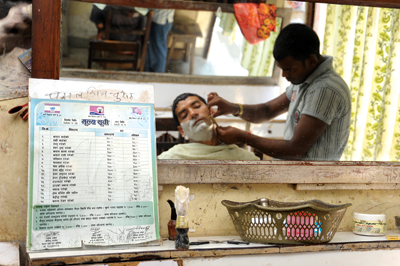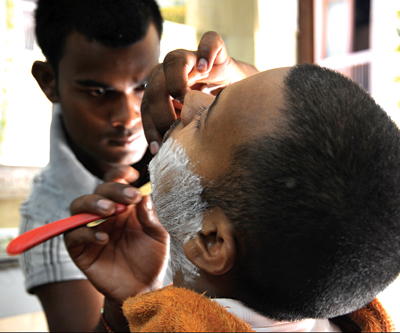The old barbershops in Nepal retain the charm of olden days.
In Pokhara, the barbershops seem to be everywhere. The Lakeside neighborhood, the most popular tourist area in this popular tourist town, is like a hall of mirrors—a long, repeating sequence of businesses, all catering to the many foreigners that populate its streets. There are guest houses, trekking goods stores, and currency exchange counters. There are restaurants and bars. And there are barbershops. Barbershops whose idle barbers hail the scruffier specimens that shuffle past their doors. Barbershops whose services include eyebrow threading and eyeball massages. Barbershops offering old-fashioned, straight-razor shaves.
 In Kathmandu, barbershops are a bit harder to find. But, after a long day’s walk and some careful looking, they too seem everywhere, hidden in plain sight. There’s one in Gyaneshwor—a closet of a shop, staffed by one old and one young man—just next to the Bhairab Temple and a few doors down from the German embassy. There’s another—larger, modern, and affiliated with the nearby Hotel de l’Annapurna (guests receive a discount)—tucked away on the second floor of a building in the upscale Durbar Marg district. There’s a third, standing in the shadow of the immense Bhimsen Tower.
In Kathmandu, barbershops are a bit harder to find. But, after a long day’s walk and some careful looking, they too seem everywhere, hidden in plain sight. There’s one in Gyaneshwor—a closet of a shop, staffed by one old and one young man—just next to the Bhairab Temple and a few doors down from the German embassy. There’s another—larger, modern, and affiliated with the nearby Hotel de l’Annapurna (guests receive a discount)—tucked away on the second floor of a building in the upscale Durbar Marg district. There’s a third, standing in the shadow of the immense Bhimsen Tower.
Shree Barbershop, the sign says. And for no particular reason, it is here, after a razor-less month spent trekking, rafting, and sightseeing in Nepal, that I decide to sit down for my first-ever old-fashioned shave.
The researching traveler can read all about getting a straight-razor shave in Nepal, both online and in guidebooks. It is something of a rite of passage among Western visitors to the country, which is unsurprising, as a shave from a Nepali barbershop has much to recommend it.
For one, a barbershop shave takes something that, in one’s own hands, is a tiresome activity and turns it into a pampering. Few men look forward to a self-shave—a boring, uncomfortable, and messy routine that is even less appealing if the beard is more than a week old. At that point, one’s facial hair is long enough to clog a double-, triple-, or even quadruple-blade safety razor and requires multiple rounds of shaving, increasing the likelihood of abrasions and nicks. But a sharp, single blade cuts through all but the bushiest facial hair with ease. Wielded by a skilled barber, it is also gentler on the skin.
 For another, submitting for the first time to a straight-razor shave, especially at the hands of a stranger, is a mildly thrilling exercise in trust-building. Head tilted back, neck offered to the blade, veins and throat bulging, the customer is very much at his barber’s mercy. Thus has a daily chore not only become a treat, it has been transformed into a modest act of derring-do.
For another, submitting for the first time to a straight-razor shave, especially at the hands of a stranger, is a mildly thrilling exercise in trust-building. Head tilted back, neck offered to the blade, veins and throat bulging, the customer is very much at his barber’s mercy. Thus has a daily chore not only become a treat, it has been transformed into a modest act of derring-do.
Finally, like much else in the country, a shave from a Nepali barber is attractively inexpensive. The cost barrier that might dissuade one from a shave in, say, New York, where old-fashioned barbershops are resurgent and can charge anywhere from $15 to $55 for the service, is nonexistent in a place like Kathmandu, where a shave begins at 50 rupees and tops out at around 150 rupees. With a price tag like that, what has the customer got to lose?
Shree Barbershop has the same rundown charm and clubby atmosphere of the barbershops I know from home. There is no peppermint-stick pole outside, but all the other totems are there: a few old photos on the wall, a yellowing poster advertising the various cuts a customer can request, a handful of older men planted on a worn-out bench, lazily chatting with each other. The only one among these men who speaks English tells me he worked at Shree for several years, but no longer does. He is freelance now, he says. He then points to a portrait on the wall of an elderly Indian man, around which hangs braids of flowers. This is the founder, he says. The shop has been open for a long time, he says. How long exactly, he doesn’t know. Twenty, thirty years. Maybe more.
 I settle into one of the shop’s eight chairs and my barber—taciturn, mustachioed—quickly gets to work, wrapping my upper body in a bib. With a soft, knob-handled brush, he works the shaving soap into a lather and mops my face with three coats of the foam. In the balmy, pre-monsoon weather of the past few weeks, my beard has been an hot, itchy burden and the shaving cream is a relief, cool to the skin.
I settle into one of the shop’s eight chairs and my barber—taciturn, mustachioed—quickly gets to work, wrapping my upper body in a bib. With a soft, knob-handled brush, he works the shaving soap into a lather and mops my face with three coats of the foam. In the balmy, pre-monsoon weather of the past few weeks, my beard has been an hot, itchy burden and the shaving cream is a relief, cool to the skin.
The barber then takes a disposable Gillette blade from a box of five and fits it into a handle. Here, the modern-day Nepali shave departs from its forebears. Traditionally, a barber would employ a fixed blade, sharpened and stropped (that is, vigorously run up and down along a leather strap, to keep its edge straight) before each use. Tradition’s loss, however, is hygiene and saftey’s gain. With a new blade per customer, there is no need to worry about being shaved by infected or improperly honed razors.
The shave itself is surprisingly smooth, the blade grazing my skin with imperceptible friction, and efficient. The barber shaves my face twice, pausing between rounds to reapply lather. Once finished, he wipes away what’s left of the shaving soap, at the same time feeling for any bristle he may have missed. Satisfied with the job, he takes a small block of alum from the counter and rubs it all over my chin and cheeks. It feels slippery and cool at first, then a bracing astringency sets in.
 The next few steps are a blur, all cleansers and lotions and massaging. There is aftershave, an overpowering chemical musk. There is a paste-thick, bluish lotion, applied with vigor, particularly (and mysteriously) to my upper lip. Last comes a blast of talc. When the powder settles, the barber has removed the bib and I get my first good look at myself in the mirror.
The next few steps are a blur, all cleansers and lotions and massaging. There is aftershave, an overpowering chemical musk. There is a paste-thick, bluish lotion, applied with vigor, particularly (and mysteriously) to my upper lip. Last comes a blast of talc. When the powder settles, the barber has removed the bib and I get my first good look at myself in the mirror.
No cuts, no razor bumps, no missed spots. For the first time since I entered the shop, the barber allows himself a smile.
I smile in return, pay up, and walk out a new man, looking more like the clean-cut face in my passport photo than I have in months. Though worth the wait, I regret not having gotten shaves throughout my time in Nepal. I could have had two, even three per week. Then again, that might’ve been habit-forming. Lord knows I couldn’t afford this luxury back home.










